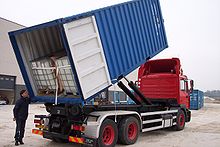- Dunnage
-
Dunnage is a term with a variety or related meanings. Typically dunnage is inexpensive or waste material used to protect and load securing cargo during transportation. Dunnage also refers to material used to support loads and prop tools and materials up off the ground such as jacks, pipes, and supports for air conditioning and other equipment above the roof of a building.
Contents
International Laws
When unloading a ship, sometimes there is a problem as to what to do with the dunnage. Sometimes the dunnage cannot be landed because of customs duties on imported timber, or quarantine rules to avoid foreign insect pests getting offshore, and as a result often the unwanted dunnage is later furtively jettisoned over side and adds to the area's driftwood problem. According to U.S. and International Law (MARPOL73/78) it is illegal for ships to dump dunnage within 25 nautical miles (46 km) of the shore. Presently, the International Plant Protection Convention (IPPC), an international regulatory agency, mandates its 134 signatory countries to comply with the ISPM 15, which requires all dunnage to be heat treated or fumigated with pesticides and marked with an accredited seal. Several instances where foreign insects have entered land have caused devastation to the ecosystem, even ruining crops and causing famine in Africa.[citation needed]
Dunnage bags
Dunnage bags are air-filled pouches that can be used to stabilize, secure and protect cargo during all sorts of transportation. Dunnage bags are placed in the void between the cargo items. Dunnage bags can be used in all modes of transportation, whether on the road, railway, ocean or in the air. This makes them a versatile load securing product to prevent a load from moving during transport.
Originally rubber bags were used to brace pallets inside trucks. They later evolved into kraft paper bags with a plastic bag interior. As the use of metal strapping became less popular, many companies now use polyethylene or vinyl- based bags because of their low cost. Extremely important in the use of dunnage bags is that the size of the bag is determined by the void. If this does not match, the dunnage bags will not do their work properly with potential for large damage to cargo and people.
Starting in the 1950s, several U.S. railroad freight carriers started rostering boxcars equipped with load-securing devices to prevent shifting during transit. These cars were usually labeled "Damage Free" or simply "DF" on their sides. The interior loaders helped to negate the use of customer-supplied dunnage.
Ships
Dunnage for securing cargo in holds of ships has evolved from wooden boards forming "cribs" to modern mechanical, spring-loaded post-and-socket systems, exemplified by the "pogo sticks" used on US Navy Combat Logistics Force (CLF) ships which provide underway replenishment of stores, spares, repair parts, ammunition, ordnance, and liquids in cans and drums. Dunnage segregates cargo in the hold and prevents shifting of the cargo in response to ship motions.
Shipbuilding
During the shipbuilding process, dunnage is commonly used term to describe items which are not considered to be part of the ship, but are nevertheless onboard the ship. Most often these items are items used by the ship yard in the construction process, but will not remain after the ship is completed. Examples of such items include welding machines, hoses, temporary ladders, and scaffolding.
Miscellaneous uses of term
Outfitters and mule packers use the term dunnage when they transport freight, such as camping gear and food supplies, but do not carry passengers. In fishing net products "dunnage" may refer to a reinforcement of the edges of the net. It is sometimes mistakenly believed to be a nautical term for sewage.
External links
References
Categories:- Building materials
- Nautical terms
- Wood
- Packaging materials
Wikimedia Foundation. 2010.


